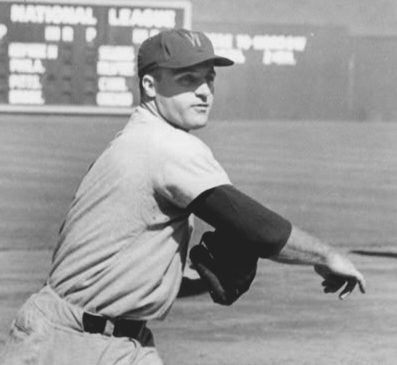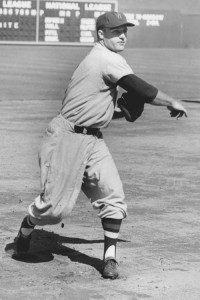

He was a player for a different era. Today, he would have been a poster child for our current obsession with sabermetrics and Moneyball. He would have been considered an out-of-place ballplayer who didn’t necessarily hit for average, yet drew walks and had a high on-base percentage.
The player I am referring to is the late Eddie Yost, who passed away on October 16 at the age of 86. During his 18-year major league career (1944-1962), Yost was a patient hitter who wasn’t afraid to take a base-on-balls.
Casey Stengel once said of him, “Every time I look up, that feller is on base.”
Thus, over time Yost earned the nickname of the “Walking Man.”
A quality third baseman, Eddie spent his entire career in the American League, playing for the Senators, Tigers and expansion Angels. In his 41 years in baseball, Yost also coached third base for the Senators, Mets and Red Sox. He was named as a reserve for his only All-Star game in 1952.
Despite hitting only .254 lifetime, Yost walked 1,614 times in 2,109 games, which is good enough for eleventh on the all-time list. He led the AL in walks a remarkable six times (1950, 1952, 1953, 1956, 1959, and 1960). His career OBP was .394, 85th all-time, and he led the AL in that category twice (1959, 1960).
In addition, Yost was great leadoff hitter. Not only could he get on base via the walk, but he also displayed some power. In 1959, he hit six leadoff home runs. He hit a total of 139 career long balls and held the lifetime record for leadoff homers with 28, a record held until Bobby Bonds surpassed him in the ’70s. He may have hit even more homers had he spent more of his career away from cavernous Griffith Stadium in D.C. For nine years beginning in 1944, Yost hit only three homers at home while hitting 52 dingers on the road.
His ability to get on base aside, he was an iron man who rarely missed a game. He led the league in games-played three times (1951, 1952, and 1954), and between 1949 and 1955, set a major league record for consecutive-games-played by a third baseman. Yost’s streak of 838 consecutive-games-played ended on May 12, 1955, when tonsillitis kept him off the field.
He was the first player to play over 2,000 games at third base. Fielding his position, Yost was third all-time for third baseman in putouts (2356) and set other records in assists (3,659), games played (2,008), and overall fielding percentage (.957%)
Edward Frederick Yost was born in Brooklyn, New York, on October 13, 1926. He played both baseball and basketball at John Adams High School in Queens and as a freshman at New York University. He played shortstop on the diamond and was a guard in hoops at NYU. He also played semipro ball in Brooklyn.
Several baseball teams were interested in Yost, including the Phillies and Red Sox. He even had a weeklong tryout at Fenway Park. However, it was the Senators who inked Yost first. Joe Cambria was the scout who signed Eddie to a cheap $500 bonus. He was just a 17-year-old kid straight out of NYU.
His major league debut came on August 16, 1944. In a 7-2 loss to the White Sox at Griffith Stadium, Yost went 1-for-3 with a single. For the season, he appeared in just seven games, batting .143 with just two hits in 14 at-bats. He walked only once.
The following season, Yost began his service in the U.S. Navy, which lasted 18 months during World War II. He never played a day in the minors, although he wanted to. He asked both Senators owner Clark Griffith and baseball Commissioner Happy Chandler if could be sent down, but the GI Bill wouldn’t allow it. The ruling was that anyone who served in the armed forces couldn’t be demoted or fired from their job for at least two years (including professional athletes).
In 1947, he became the Senators’ full-time third baseman. Those teams of the late 1940s were dreadful. So much so that Hall of Fame sportswriter Charles Dryden’s immortal words were again invoked to describe the franchise: “Washington — first in war, first in peace and last in the American League.”
In 1950, Yost hit for a career best .295 batting average and .440 OBP. The following season he led the league in doubles with 36.
Some managers approved of Yost’s propensity for the walk, while other’s didn’t. White Sox manager Paul Richards most definitely fell into the latter category. In 1952, Richards didn’t want Yost to show up his pitching staff, telling his hurlers that if they walked him, they would be fined $25. Even with the rule, Yost couldn’t be stopped. By the end of the season, White Sox pitchers walked him 23 times, a total penalty of $575.
Former Brooklyn Dodgers manager Charlie Dressen, who coached Yost between 1955 and 1957, was more traditional in his intentions on how to use his OBP machine. “I’m going to drop Yost down (in the lineup) … he’ll be a better hitter if he’s not trying to get that walk, and my schooling in this game has been that you can drive in more runs with base hits than walks.”
A previous manager, Hall of Fame skipper Bucky Harris, went so far as to say that he would have liked to make a clone of Yost. “What I’d like to have is a pair of Yosts: one to lead off and another to drive in some of those runs with the hits he makes.”
Explaining his gift for the free pass, Yost told Sports Collector’s Digest in 2002,
“It’s something you can’t teach. Just something I was lucky enough to be born with. I had a good eye and knew the strike zone. … Back then a lot of pitchers threw rising fastballs, and I found that if I could lay off them and didn’t swing, they would be called balls … after a while I got a reputation for walking a lot. Umpires began to give me the calls on the close ones.
“I took some pretty good strikes … if I’d been hit-crazy, I’d have finished with a better average, perhaps, but I wouldn’t have been playing the percentages for the good of the team.”
Yost’s time with the Senators ended when a young infielder named Harmon Killebrew was on the rise. This made Yost expendable from the only team he ever knew. After 14 years with the Senators, Eddie was dealt to the Detroit Tigers as part of a six-player deal on December 6, 1958.
In both of his seasons in Detroit, Yost led the league in base-on-balls and OBP. He also scored an AL best 115 runs.
After the 1960 season, the American League added two new franchises in Minnesota and Los Angeles (although, technically, the Twins came over from Washington and the Senators reemerged in D.C.). Yost was left unprotected by the Tigers and drafted by the Angels in the expansion draft. He played two seasons with L.A. and made history as the first Angel ever to come to bat. By then he was 34 years old and had the worst averages of his career. Although he was still getting on base, his average dipped to .202 in 1961.
Not surprisingly, Yost drew a walk in his final plate appearance on July 28, 1962.
Briefly a player-coach with the Angels in ’62, Eddie returned to D.C. to coach third base for Senators manager Mickey Vernon. In between skippers, Yost even managed one game himself on an interim basis. He took the loss, as his Senators fell to the Chicago White Sox, 9-3, at D.C. Stadium.
When Gil Hodges, who had replaced Vernon, was hired to manage the New York Mets, he took his coaching staff with him, including Yost. Eddie coached third base for the Mets for nine years, continuing even after Hodges’ death in 1972. Yost never won a championship as a player, but got a World Series ring for being in uniform for the ’69 “Miracle” Mets.
Yost’s career in baseball ended in 1984 after coaching the hot corner for the Boston Red Sox for eight seasons. During his Presidential run in 2004, Massachusetts Senator John Kerry cited Yost as his favorite Red Sox player. This was all well and good except for one small problem. While Eddie Yost may have been a great coach along the third base line, he never actually stepped into a batter’s box for Boston.
During his offseason, Yost earned a Master’s degree in physical education from NYU. After his retirement, Eddie and his family settled in Wellesley, Mass. Among other things, he enjoyed a longtime hobby of repairing antique clocks.
Yost was always humbled by his longevity and contributions to the game.
“I feel very fortunate having been part of baseball for those many years. It was something I dreamt of as a child.”
SOURCES:
“Mets Long Time Coach, Eddie Yost, Passes Away”. by Tie Dyed. Metsmerizedonline.com, October 18, 2012.
“Recalling the ‘Walking Man’, Eddie Yost’s Remarkable Career,” by Jeff Stuart. Bob Davis SABR Chapter newsletter, November, 2006.
Eddie Yost, SABR BioProject. by Andrew Schiff and Matthew Silverman.
“Eddie Yost, Baseball’s Walking Man, Dies at 86,” by Bruce Weber, New York Times, October 17, 2012.
“Eddie Yost, the Washington Senators’ ‘Walking Man’ of the 1950s, dies at 86,” by Matt Schudel, Washington Post, October 17, 2012.
“Player Profile: The Walker Man.” by Arnold Bailey. Sports Collector’s Digest, January 18, 2002.
Baseball-reference.com
Retrosheet.org




